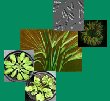| Fetene, P; Gashaw, M; Nauke, P; Beck, E: Microclimate and ecophysiological significance of the tree-like life-form of Lobelia rhynchopetalum in a tropical alpine environment, Oecologia, 113, 332-340 (1998) [Link] | |
| Abstract: The microclimate and the adaptive significance of the tree-like plant life-form for growth in a tropical alpine environment was investigated with the pachycaul arborescent giant rosette plant, Lobelia rhynchopetalum (Hochst. A. Rich.) Hemsl. in the Bale and Simen Mountains, Ethiopia. The microclimate of plants of three height classes was examined with respect to temperature, relative humidity and the effect of wind. Although the total heat gains were rather similar, leaves of young, still stemless (acaulescent) individuals of Lobelia were subjected to a high diurnal temperature fluctuation of up to 29 K compared to a 14-K fluctua- tion for the leaves of an individual 3.5 m in height. During the cold nights, temperatures of the inner rosette leaves and inside leaf buds of caulescent plants were 4-5 K above air temperature, while corresponding temperatures of acaulescent individuals were 1-2 K be- low air temperature. The inner temperature of the stem tissue was higher than the surface temperature of the stem by about 5 K for most of the cold night. The an- nual rates of increment in whole plant, stem and rosette height, and stem diameter of L. rhynchopetalum showed that the young, still acaulescent individuals, with an annual increment of 5.6 cm in plant height, had the lowest growth rate, compared to 12.1 and 22.1 cm for caulescent life-forms. The results show that the most important advantage gained by the tree-like life-form of adult L. rhynchopetalum is probably a more favourable microclimate in which the strong diurnal temperature fluctuations at the ground are mitigated and nocturnal temperatures do not drop below freezing point. |

Letzte Änderung 02.07.2020

